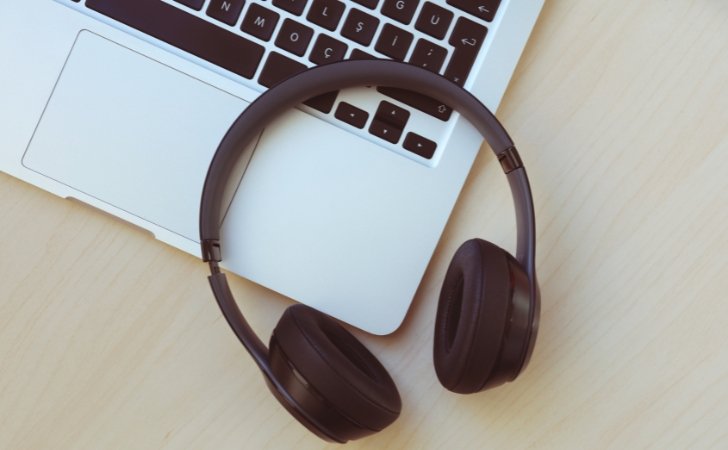AFFILIATE DISCLOSURE
This post may contain affiliate links. An affiliate means Escribr may earn referral fees if you make a purchase through our link without any extra cost to you. It helps to keep this blog afloat. Thanks for your support!
Did you know that by visiting this blog, you are doing good in the world? READ THIS.
Ever wondered how pros turn hours of audio into written records? It’s all about mastering audio transcription. This guide will show you how to get better at converting audio to text, making you a pro at transcription.
We’ll cover everything from getting ready to type to the best equipment and typing tricks. This guide is for anyone, whether you’re new or experienced. It will help you type audio fast and accurately.
Understanding Audio Transcription Fundamentals

Audio transcription turns spoken words into written text. It’s a key skill in today’s digital world. This process makes audio recordings searchable and editable, offering many benefits for people and businesses.
What is Audio Transcription?
Audio transcription means listening to recordings and typing out what’s said. It covers interviews, meetings, and lectures. The transcript keeps the original audio’s words and context.
Benefits of Audio-to-Text Conversion
- It makes audio content accessible to those who can’t hear well or prefer reading.
- Transcripts help find specific information in large audio files easily.
- They can be used to create new content like articles or subtitles, making the original material more useful.
Common Use Cases for Transcription
Audio transcription is used in many fields, including:
- Legal Industry: Lawyers use it for court records, depositions, and client talks.
- Business Sector: Companies transcribe meetings and interviews for clear records.
- Law Enforcement: Police use it for interviews and field notes to aid investigations.
- Medical Field: Doctors document patient talks and medical plans with transcription.
- Media and Content Creation: Journalists and podcasters use it to make their content more accessible.
- Insurance Adjusters: They transcribe interviews and reports for accurate claims.
- Financial Advisors: Advisors transcribe client meetings for detailed records.
As technology advances, audio transcription will become even more important. It helps us capture and use spoken words in our daily lives and work.
Essential Equipment and Tools for Transcription Success
Getting the right tools is key to successful transcription. You’ll need a reliable computer or laptop, top-notch headphones, and a foot pedal. The right setup boosts your productivity and accuracy.
Express Scribe is a must-have transcription software. It offers playback controls, time-stamping, and works with speech recognition. For a free option, try Google Docs Voice Typing or Microsoft Word’s transcribe feature. They make converting audio to text easy.
For big projects, professional transcription services are a lifesaver. They have teams of experts for quick and accurate work. Sonix, Happy Scribe, and Riverside.fm are great choices. They have plans for all budgets.
| Transcription Tool | G2 Rating | Pricing |
|---|---|---|
| Fellow | 4.7/5 (2,063 reviews) | Free plan; paid plans from $7/user/month |
| Trint | 4.4/5 (65 reviews) | Paid plans from $80/user/month |
| Fathom | 5/5 (2,279 reviews) | Free plan; paid plans from $19/month |
| Sonix | 4.7/5 (22 reviews) | Paid plans from $22/user/month; free plan available |
| Vocalmatic | 4.5/5 (5 reviews) | Paid plans from $15/month; no free plan |
| Descript | 4.6/5 (447 reviews) | Free plan; paid plans from $12/user/month |
| Audext | 4.8/5 (2 reviews) | Paid plans from $5/hour; free trial available |
| Happy Scribe | 4.8/5 (21 reviews) | Paid plans from $10/month; free plan available |
| Riverside.fm | 4.8/5 (717 reviews) | Free plan; paid plans from $15/month |
Choosing the right tools and equipment is crucial for transcription success. With the latest transcription tools, voice typing, and speech-to-text apps, you can work more efficiently. This leads to better results and higher productivity.
Setting Up Your Transcription Workspace
To work well on audio typing, you need a great workspace. It should be quiet and free from distractions. This helps you stay focused and accurate. Also, setting up your workspace ergonomically can prevent fatigue and injury, making long work hours easier.
Creating an Optimal Environment
Find a spot that’s away from noise and interruptions. If you can’t have a private room, use noise-cancelling headphones or a white noise machine. Good lighting and a comfortable temperature also help you stay focused.
Ergonomic Considerations
Good posture and the right equipment placement are key for your transcription workspace. Get a chair that adjusts and supports your back. Your desk should be at a height that lets your forearms rest comfortably. Place your monitor, keyboard, and mouse to avoid neck and wrist pain.
Technical Setup Requirements
Your audio typing environment needs the right software and hardware. Use reliable transcription tools like Otter.ai or Trint. Make sure your audio devices work well and your internet connection is stable, especially for cloud-based tools.
| Transcription Tool | Key Features | Pricing |
|---|---|---|
| Otter.ai | – Real-time transcription – Speaker identification – Automated punctuation | Free plan available Premium plans start at $8.33/month |
| Trint | – Accurate transcription – Time-stamped captions – Easy collaboration | Plans start at $42/month |
| Google Docs | – Free in-built transcription – Lacks punctuation and speaker differentiation | Free with Google account |
By setting up a great transcription workspace and focusing on ergonomics and tech, you can work better. This means you’ll be more productive, avoid physical problems, and make top-notch audio transcriptions.
Audio Typing Example: Step-by-Step Process
Learning the audio typing process is key for quick transcription and converting voice to text. It’s vital whether you’re a pro or just starting out. Knowing the steps makes the task easier. Let’s look at the main stages of the audio typing process.
- Prepare the Audio File and Workspace: First, make sure you have a good audio file. Then, set up your workspace with a comfy chair, headphones, and a text editor or transcription software.
- Listen to the Entire Recording: Listen to the whole recording once. This helps you get the content, speakers, and context. It makes understanding the conversation easier.
- Start Transcribing: Now, start typing. Use controls to adjust the audio speed. Pause and rewind as needed. Use proper formatting and punctuation.
- Note Non-Verbal Cues and Speaker Changes: Pay attention to non-verbal cues and speaker changes. Adding these details makes your transcript better.
- Review and Edit the Transcript: After finishing, review the transcript for accuracy. Make any needed changes to ensure it’s top-notch.
Experienced transcribers usually take 4-6 hours per hour of audio. By following these steps, you can make the transcription process smoother. This leads to accurate, well-formatted documents for your audience.
| Transcription Method | Time Requirement |
|---|---|
| Automatic Transcription | Minutes |
| Manual Transcription | 2-10 hours per hour of audio |

The audio typing process is crucial for transcription. Mastering it can lead to more content creation, repurposing, and making things more accessible. By following these steps and using the right tools, you can make high-quality, SEO-friendly transcripts easily.
Mastering Transcription Software and Tools
Transcription software and tools are key to making audio-to-text conversion easier. Options like Express Scribe and Transcriber Pro, along with speech recognition tech, boost efficiency and accuracy. They make transcription tasks smoother.
Popular Transcription Software Options
Software like Express Scribe, Transcriber Pro, and oTranscribe make transcription easier. They have user-friendly interfaces and advanced playback controls. These tools also help manage files well, making audio processing simple.
Speech Recognition Technologies
Speech recognition tech, like Dragon NaturallySpeaking, automates transcription. These AI tools turn spoken words into text quickly and accurately. As they get better, they become more valuable for transcription work.
File Management Best Practices
Good file management is essential for efficient transcription. Use consistent naming and organize files and transcripts well. Also, keep backups safe to protect data and ensure easy access to files.
| Transcription Software | Pricing | Key Features |
|---|---|---|
| Express Scribe | Free (Pro version $29.95) | Playback controls, foot pedal support, file management |
| Transcriber Pro | $59.95 | Time-stamped transcripts, speaker identification, video support |
| oTranscribe | Free | Web-based, keyboard shortcuts, synchronized playback |
Voice Recognition Technology and Digital Solutions
In the world of audio transcription, voice recognition technology has changed the game. These tools use artificial intelligence (AI) to make transcription fast and accurate. Notta is a top example, offering top-notch results in many languages.
Notta is great at handling tough audio files. It can tell who’s speaking and gives transcripts with exact times. This saves a lot of time and makes work easier. It’s easy to use and helps users do their jobs better.
Even with voice recognition technology and digital transcription solutions, human checks are still key. They’re needed for the best results, especially with complex recordings or many speakers. Combining tech and human skills gives the best transcription quality for all kinds of work.

The need for quick and accurate transcription is rising. Thanks to AI transcription, we’re seeing big changes. Voice recognition and digital tools are making transcription faster, more accurate, and cheaper for everyone.
Time Management and Productivity Tips
Effective time management is key for success in transcription work. As a transcriptionist, it’s important to set realistic deadlines. This depends on the audio’s length and complexity. The 45-15 rule is a simple yet powerful strategy to stay focused and avoid burnout. It involves working for 45 minutes, then taking a 15-minute break to recharge.
Tracking your progress is also vital for staying productive. Use time-tracking tools or a detailed spreadsheet to monitor your efficiency. This helps you improve your transcription workflow and balance work and breaks.
Setting Realistic Deadlines
When starting a transcription project, assess the audio’s length and complexity. Set deadlines that are realistic to avoid rushed work. This ensures you deliver high-quality transcripts on time without harming your well-being.
Break Scheduling Strategies
Transcription productivity and work-break balance are closely linked. Regular breaks help maintain focus and prevent burnout. The 45-15 rule keeps you energized and engaged all day.
Progress Tracking Methods
It’s important to monitor your time management and productivity. Use time-tracking tools or a spreadsheet to track your progress. This data helps refine your workflow, ensuring you use your time well and deliver great results.
Common Challenges and Solutions in Audio Typing
Transcribing audio recordings can be tough, even for experts. Transcription challenges like bad audio quality, background noise, and multiple speakers slow down the work. They also affect how accurate the final transcript is.
One big problem is audio quality issues. Sounds like traffic, overlapping talks, wind, and machinery make it hard to get the words right. Indoor recordings can have echo, while outdoor ones might have distant noises.
- Using noise-cancelling headphones and adjusting audio settings can help with background noise.
- Advanced audio editing software can cut down on background sounds, making the recording clearer.
- Directional microphones can focus on the speaker, reducing outside noises and improving quality.
Another challenge is multiple speaker transcription. It’s hard to keep track of who’s speaking and get each voice right. Transcriptionists must be careful to mark speaker changes and keep the transcript accurate.
When dealing with technical terms, transcriptionists need to do their homework. They should research and understand the context to get it right. This is especially important in fields like journalism, emergency response, and scientific research.
For tough audio, transcriptionists might use professional services or advanced software. These tools can improve accuracy and speed. By tackling these challenges, transcriptionists can provide top-notch transcripts that meet client needs and add value to their services.
Advanced Techniques for Professional Transcription
As a professional transcriptionist, it’s key to learn advanced techniques. These skills help you deliver top-notch results and work more efficiently. You can improve your services by using shorthand, quality control, and following specific guidelines.
Shorthand and Speed Writing
Experienced transcriptionists use shorthand and speed writing to type faster. They make shortcuts for common words and phrases. This cuts down typing time a lot.
Tools like PhraseExpress, TextExpander, and AutoHotkey help even more. They turn your shortcuts into full text automatically.
Quality Control Measures
Keeping your transcripts accurate and reliable is crucial. Professional transcriptionists use many quality checks. They review, proofread, and compare with the original audio.
These steps ensure your work is always precise. It’s vital for keeping your clients happy.
Format and Style Guidelines
Following format and style rules is a key part of professional transcription. This includes using special notations for non-verbal cues and timestamps. It also means clearly identifying who is speaking.
By mastering these techniques, you create transcripts that are not only correct but also easy to read and understand.











